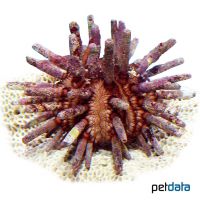Caribbean Slate Pencil Urchin (Eucidaris tribuloides)
| Caribbean Slate Pencil Urchin Eucidaris tribuloides | |
|---|---|
| Name | Caribbean Slate Pencil Urchin |
| Name Lat. | Eucidaris tribuloides |
| Family | Cidarid Sea Urchins |
| Family lat. | Cidaridae |
| Order | Sea Urchins |
| Order lat. | Cidaroida |
| Origin | Western Atlantic |
| Diet | Omnivore |
| pH | 8.1-8.4 |
| Hardness | 6-10 °KH |
| Lighting | Medium |
| Current | Moderate |
| Behavior | Nocturnal |
| Keeping | Individual |
| Care Level | Moderate |
| Life Span | N/A |
| Protection | No |
| Metric Units | |
| Size | 10-13 cm |
| Temperature | 22-27 °C |
| Salinity | 33-36 ‰ |
| Aquarium | 200 l |
| US Units | |
| Size | 3.9"-5.1" |
| Temperature | 72-81 °F |
| Salinity | 1.020-1.025 sg |
| Aquarium | 50 gal |
Distribution and habitat
The distribution area of Eucidaris tribuloides is the tropical West Atlantic, from the Caribbean through the Gulf of Mexico to Brazil, as well as in the East Atlantic on the West African coast and Cape Verde. They live in lagoons with seagrass beds, hidden between rocks and crevices during the day.
Maintenance
They need a well structured aquarium with a reef structure, with caves and crevices where they can retreat during the day, as well as stably anchored live rocks that they can graze on (algae) and that act like a biological filter
Only substrates rich in lime and free of heavy metals may be used as substrate. Filters, skimmers and heaters are necessary to ensure water quality, as well as pumps to simulate tides, swells and bottom currents. Lighting must match the species-appropriate day-night rhythm of the animals
| Salinity: 33-36 ‰ | pH value: 8.1-8.4 |
| Carbonate hardness: 6-10 °KH | Nitrate content: 2-8 mg/l |
| calcium content: 400-450 mg/l | Nitrite content: 0.0-0.05 mg/l |
| Magnesium content: 1.250-1.350 mg/l | phosphate content: 0.01-0.1 mg/l |
Regular addition of trace elements is recommended. For salinity, an average value should be aimed for, which may only vary slightly by +/- 0.5 ‰. Ammonia and ammonium must not be measurable. Special attention shall be paid to consistently good water quality and water values.
Diet
In nature, the nocturnal animals feed mainly on algae, which they graze from stones and substrate, whereby also calcareous algae as well as incrustated invertebrates, such as sponges, bryozoans, etc. are rasped off. The food supply consists of protein-rich food tablets as well as mussel meat and, if algal growth is too low, dried seaweed (Porphyra umbilicalis) or algal leaves (norialgae). When scraping, they absorb the lime from stones and substrate necessary for their skeletal structure. However, additional soft lime, such as cuttlebone, should be offered to ensure a sufficient supply of vital lime
Regular and varied feeding promotes health and increases resistance.
Behaviour and compatibility
In nature they live individually or in small groups. In a well-structured aquarium with sufficient food supply (algae), several animals can be kept together. They can be well socialized with fish and invertebrates that they do not consider food. Caution is advised with sessile invertebrates, such as sea squirts, small tubeworms, sponges, soft corals, etc., which also serve as food for them.
Reproduction and breeding
They are separately sexual and have no external sexual characteristics. The larvae are part of the plankton for several months until they sink to the bottom and turn into small sea urchins (metamorphosis)
There are no known reports of successful breeding in the aquarium.
Important
They have very long primary spines covered with a calcareous covering layer, which are often covered with algae, bryozoans, sponges and small mussels. Next to the primary spines are many small secondary spines grouped in tufts.
Care should be taken when transferring them. Sea urchins should not be allowed to come up for air, as air bubbles can form in their water-filled respiratory system, which would cause suffocation.
Sting injuries can be very painful and result in inflammation.
If different species are kept together, care must be taken to match fish and invertebrates in terms of water quality and temperature requirements, as well as their social behavior, and to ensure that the setup meets the ecological needs of all species kept together. Newly introduced animals must be acclimated slowly to the water in the aquarium
Further literature can be found in your pet store.
References
Text: petdata; Image: petdata
Source: ENGELMANN & LANGE (2011): Zootierhaltung - Tiere in menschlicher Obhut: Wirbellose, Verlag Harri Deutsch; KNOP (2013): Lexikon der Meeresaquaristik, Natur und Tier Verlag
